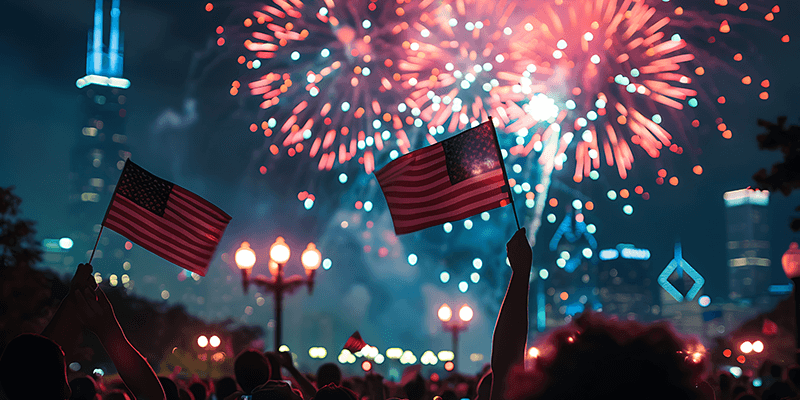8730 Wilshire Boulevard, California 90211
Get Help Now
8730 Wilshire Boulevard, California 90211
Get Help Now

For many people, Independence Day is the happiest and saddest day of the year. Everyone likes a good fireworks show, especially if the soundtrack includes a clip from the Springsteen classic Born in the U.S.A. At the same time, 73 percent of all fireworks accidents occur in the days immediately around July 4th. These accidents cause a wide range of serious injuries. More on that below.
Legally, these accident claims are very complex, mostly because multiple parties may be at fault, such as a manufacturer who made and sold a defective product, a displayer who dropped the ball, and even the victims themselves. In many states, attorneys can sue somebody and let possibly multiple defendants fight it out among themselves. But California is not a “shoot first and ask questions later” state. An attorney must bet it right the first time.
For a California Fireworks Accident Attorney, getting it right the first time means working hard from start to finish. A lawyer must thoroughly evaluate your case, identify all legal issues, and pinpoint responsible parties. Next, the legal team must gather evidence that supports the victim’s claims and refutes possible defenses. Finally, a personal injury attorney must be a good negotiator because most personal injury claims settle out of court.
Before we break down these injuries, we should address the chemical composition of fireworks. Picric acid is the main active ingredient in many fireworks. This chemical was used in artillery shells, bombs, hang grenades, and other military explosives until the early part of World War I, when most armies began using TNT, a much more powerful explosive.
That’s one of the main reasons Post Traumatic Stress Disorder (shell shock) was so common in World War I. The picric acid-to-TNT transition made explosions much louder and more violent. But that’s the subject of another blog.
Many displayers feel that this year’s fireworks show should always outshine last year’s show. Largely for that reason, fireworks accidents have increased 25 percent since 2006.
Serious burns are the most common fireworks injuries, such as temperature burns, mostly on fingers and hands. Explosives like picric acid usually cause third-degree burns, which doctors must treat with skin grafts.
Fireworks, especially sparklers, also cause chemical burns. In severe cases, fireworks rupture the globe of the eye, causing chemical and thermal burns, corneal abrasions, and retinal detachment, all of which can cause permanent eye damage and vision loss. Making matters worse, fireworks-related eye injuries can combine blunt force trauma, heat burns, and chemical exposure.
These blunt force trauma injuries usually include mTBIs (moderate traumatic brain injuries). Usually, mTBIs, a/k/a concussions, aren’t life-threatening. However, if the victim had sustained prior concussions, a new one could be the straw that broke the camel’s back and cause CTE (chronic traumatic encephalopathy), a degenerative disease that’s usually fatal.
We mentioned possible responsible parties above. Now, in the spirit of this post, let’s break it down a little further.
Companies have a legal responsibility to make and sell safe products. If their products are unsafe, and an unsafe product causes injury, the company is legally responsible for damages. If you’ve been impacted by a potentially faulty product, seeking guidance from a product liability lawyer could be beneficial
Damages in a personal injury case normally include compensation for economic losses, such as medical bills, and noneconomic losses, such as pain and suffering. Additional punitive damages are usually available in these cases as well.
Similarly, fireworks displayers, whether for-profit or nonprofit, have a duty to ensure their displays are reasonably safe. This duty includes a responsibility to put safety first in the design and frequently inspect the fireworks and display area to ensure continued safety.
Let’s face it. Sometimes, people mishandle fireworks and hurt themselves. In these cases, the court might reduce a property owner’s liability, but probably not a manufacturer’s liability, unless the victim’s misuse was extreme (e.g., picking your nose with a sparkler).
We also mentioned negotiation skills above. A Los Angeles personal injury attorney must be thoroughly prepared, know when to compromise and know when to stand firm.
Preparation means knowing a claim’s settlement value, which is usually the combination of economic losses, noneconomic losses, and appropriate punitive damages. Preparation has an intangible component as well. For example, some victims want to settle cases quickly, so they’re willing to take less money.
During negotiations themselves, attorneys must make proper offers and counter-offers. Otherwise, the victim may end up settling for less, or the settlement might be unduly delayed. Neither outcome is acceptable to a victim or a Los Angeles personal injury lawyer.
Awe-inspiring fireworks often cause serious injuries. For a free consultation with an experienced personal injury attorney in Los Angeles, contact the Law Offices of Eslamboly Hakim. Virtual, home, and hospital visits are available.
Photo By Freepik
Tag: